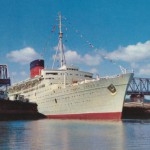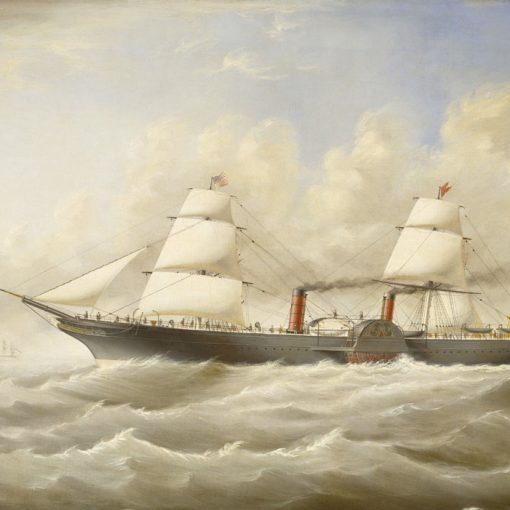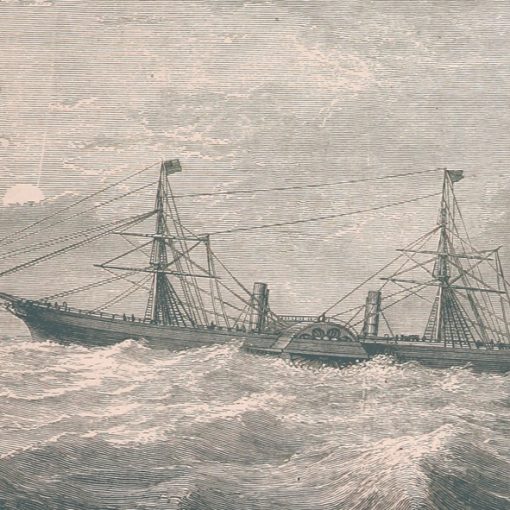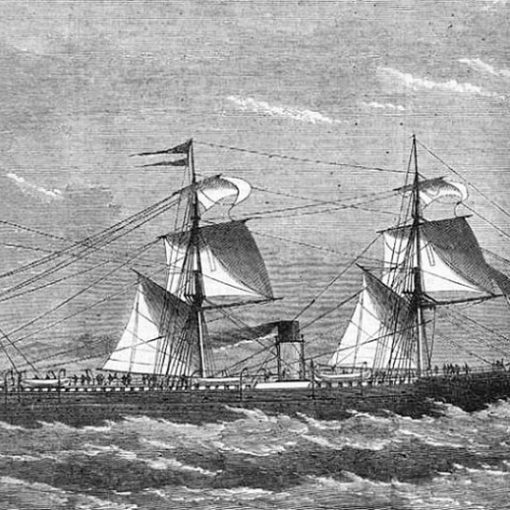1949 – 1974
Also known as Columbia and Caribia
After the Second World War, Cunard White Star set out to re-establish the company as the greatest on the North Atlantic. The two Queens had served well in the war along with other vessels such as the second Mauretania and the old Aquitania, and these ships would now be used for commercial purposes for the first time in almost seven years. With the two Queens in passenger service, Cunard White Star had finally fulfilled their long-time dream of a two-ship weekly express service across the North Atlantic. The Mauretania was used as something of a relief-ship, working alongside the mighty Queens when she was needed. Otherwise she maintained her own service between Southampton and New York, as well as spending much time cruising in warmer waters.
In 1946, Cunard ordered from John Brown & Co. Ltd. what was supposed to be a running mate for the Mauretania. The new ship would be just slightly smaller than the Mauretania, with a size of some 34,000 tons. However, before construction had come far, Cunard changed their mind. In the hard times of the Depression in the beginning of the 1930s, cruising had become a new use of the great ships of the world. Starting as so-called ‘booze-cruises’ from New York, cruising had become more popular, and it was possible that a great future lay in this concept.
With this in mind, Cunard decided to gamble. The new ship being built in Scotland on the banks of the River Clyde would be constructed as an all-out cruise ship. On October 30th 1947, the new ship was ready to be launched. Her Royal Highness Princess Elizabeth had agreed to christen the new vessel to show the Royal family’s gratitude for the Queens’ services during the war. The launch of Cunard’s latest ship was her last public engagement before her forthcoming marriage. Smashing a bottle against the bow of the ship, the princess then named her Caronia.
After fitting out and satisfactory sea trials, the Caronia set out on her premiere voyage on January 4th, 1949. Although the ship would be used almost only for cruises, the maiden voyage was between Southampton and New York, calling at Cherbourg on the way.
As already mentioned, the Caronia would sail as a cruise ship most of her time, and she was certainly designed with just that purpose in mind. Her bow was raked forward, giving her a yacht-like appearance. She had a lone funnel, painted in Cunard’s familiar livery of black and orange-red. Actually, the funnel of the Caronia was one of the largest ever installed on a ship, and the mast was the tallest one afloat. But the most striking feature of the Caronia was undoubtedly the ship’s colour scheme – she was painted in four shades of light green, and this would soon earn her the flattering nickname ‘The Green Goddess’. She was the first Cunarder with a built-in outdoor swimming pool and the first to offer private bathrooms in every stateroom, regardless of class.
During her first winter in service, the Caronia made a number of cruises to the West Indies and South America. Almost instantly she earned a reputation of being one of the most luxurious ships afloat; some even thought she outmatched first class on board the two Queens. Much of this reputation originated from the service provided on board The Green Goddess. The ship’s passenger capacity was only about 900 people, and the number of crew was almost equal. The ship’s stewards were handpicked and always wore well-starched white jackets. Many passengers travelled on board the Caronia many times, and the ship’s clientele soon achieved an atmosphere of familiarity. In fact, some passengers brought with them paintings and furniture of their own to make their staterooms more personal.
But extra furniture and paintings were not really needed. The Caronia’s interiors were done in a late Art Deco-style, smaller versions of the Queen Elizabeth’s interiors, and provided a high quality of shipboard comfort. After two years of service, the Caronia set out on her very first world cruise in January 1951. Calling at more than 30 ports across the globe, the long voyage ended at Southampton in the spring. A minor mishap occurred while the Caronia was in the Suez Canal, when she ran aground. Luckily, the ship was afloat after an hour and had avoided damage. The only bad thing to come out of this small accident was the unforeseen delay of traffic through the channel. In the summer of 1951, Caronia made a cruise from New York to Europe.
In the summer of 1953, the Caronia was chartered to carry guests to the Queen’s Coronation ceremony in Great Britain. It was a fine way to repay Elizabeth for naming her five years earlier. Through the following years, the Caronia operated after a fixed schedule making one world cruise and several smaller ones to for instance Scandinavia and the Mediterranean. Occasionally she also appeared periodically on the transatlantic run. In 1956 the Caronia once again ran aground, this time on a sandbank off the port of Messina. But with her good luck still accompanying her, the Caronia was floated off shortly afterwards. By the end of that same year, The Green Goddess was fitted with complete air-conditioning during her annual overhaul.
Upon her return to service, Caronia was put on a new run from New York to Cape Town and then back again via the Pacific. But on her second voyage on this route she had an accident when she demolished a light tower at the entrance of Yokohama port on April 14th, 1958. The damages were quite severe, and the ship needed instant repairs. Fortunately, the US Navy allowed Caronia to occupy the Yokosuka dockyard while these were carried out. Cunard then fought a legal battle that they eventually lost, resulting in them paying a large amount of compensation.
By the mid-1960s, other shipping companies were following Cunard’s lead and were building special cruise ships of their own. Being newer, these ships were naturally more modern and well-equipped than the ageing Caronia. To be able to compete with them, Cunard let the Caronia go through a major refit in October 1965, during which she was given a large lido deck and a new outdoor swimming pool. Her interiors were also brought up to date.
But the market was getting harder, and all the improvements on the Caronia did no good. Cunard was facing very bad times and announced that the Caronia, Carinthia and Sylvania were to be removed from service in the beginning of 1968. The Caronia set out on her last voyage from New York to Southampton on November 17th, 1967. She then remained in Southampton while Cunard tried to find a buyer for her. Eventually they came to an agreement with the Yugoslavian company Domus Turist. Their plans were to use the old Caronia as a floating hotel at Dubrovnik. But the transaction was never completed, and the Caronia was then resold to the company Star Shipping on May 24th, 1968. She was renamed Columbia and was sent to the Greek port of Piraeus in July to go through a refit for her new owners. During this refit, she was again renamed, this time she was given the name Caribia.
Her new owners intended to use her for what she had been built – cruising. When she was finished, the Caribia left New York on her first cruise for her new company on February 11th, 1969. However, service and comfort were low, and many passengers filed complaints. Despite this, the ship set out on a second cruise on February 28th. But during this voyage a terrible accident occurred when a steam pipe split and killed a crewmember. The Caribia was left without power and was left drifting helplessly. Temporary repairs were made, and the ship could return to New York after 20 hours.
Star Shipping had no more interest in the ship, and so it was again sold to a Turkish company. Their intention was to refit the ship again, but they never managed to gather enough funds to accomplish this task. For the following five years, the former Caronia remained in New York at different anchorages.
In the spring of 1974, the ship was finally sold to a Taiwanese shipbreaking firm. But before she was delivered, an auction was held on board. Practically everything on board the former great ship was for sale and by the time the auction was over, almost everything had been taken away. Then, on April 27th 1974, the former Caronia left New York for the last time, bound for Kaohsiung. She could not make the voyage under own power, but had to be towed by the ocean tug Hamburg.
When just outside of Honolulu, the old ship took on a dangerous list. Temporary repairs had to be made, but when these were finished the two vessels could resume the voyage. However, the bad luck would continue. On August 12th, they were battling a tropical storm off Guam. Three miles from Apra Harbour, the Hamburg’s generators failed, and the captain made the decision to cut the towline. The old Caronia was left drifting in the heavy seas and was nearing the harbour entrance beyond control. At first it seemed as if she would manage to drift into the calm waters of the port on her own, but all of a sudden she changed her course. The old ship was violently hurled against the tip of the harbour’s breakwater and broken in three. The wreckage was a menace to shipping in the area and was quickly cut up on the spot. Thus ended the days of Cunard’s fabulous Green Goddess.
Specifications
- 715 feet (218.4 m) long
- 91 feet (27.8 m) wide
- 34,183 gross tons
- Steam turbines turning two propellers
- 22 knot service speed
- Passenger capacity of 932 people












4 thoughts on “Caronia (II)”
In 1965 at the end of my first year at UC Berkeley, my 75 year old great aunt took me on an amazing 3 month trip around the world, starting in Hawaii and proceeding through Asia, north Africa, and Europe. To be trite, it was the experience of a lifetime, with rides in sampans, pedicabs, gondolas, on brilliantly outfitted elephants and camels, touring ruins, museums, and castles, and experiencing every cuisine imaginable.
After visiting relatives stationed in Turkey, others in Italy, Germany and England, we boarded the Caronia in Southampton for our return to New York before heading home to the SF Bay Area. This was the crowning event of our entire summer. What an incredible experience for this wide-eyed innocent! It was like being on a floating city for 8 nights—no amenity lacked. no need or wish went unattended. The crew was peerless, caring, and attentive throughout our voyage. When we arrived in New York, our handsome dining room waiter from the Isle of Man, Michael McClaverty, invited me out to dinner and a show at Radio City. The entire experience had the effect of stepping into a Jane Austin novel, and never will be forgotten!
Nice article though one part is not quite correct. The sale of Art Deco pieces from the
ship was not held on board but in one of the pier sheds long after Caribia had been
towed away. It wasn’t until most of the stuff had been sold and collected that the New
York authorities woke up to what was going on and looking to charge “import duties”
on what was essentially scrap, mostly made in Scotland in the 1940s or earlier.
Full daily history of the ship at https://caronia2.info/
A great resume, but a few errors. The contents of the ship were stripped out and not sold until some time after she was towed away from New York. I don’t believe there was any Turkish interest in the ship. Mr. Konstantinidis was very much Greek!
As its webmaster, could I request a return link to the Caronia Timeline?
I’ve had one in place to this site like forever…
https://caronia2.info/
Great Documentation…Keep our Maritime History alive!!!!!!!!, Ian Robertson. http://www.oceanlinerrow.com